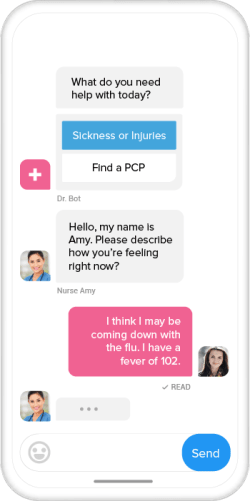Telemedicine enables patients to receive interactive medical care from healthcare providers from anywhere with an internet connection. Telehealth services include treatment services, follow-up medical services, giving medical advice, transmitting medical information, and other healthcare services like mental health treatment.
A telemedicine consultation visit eliminates wait times in a medical center. Telehealth is transforming the healthcare industry by reducing costs in the health system, improving patient health, enhancing medical education, enhancing the safety and effectiveness of care, and addressing health disparities. Telemedicine services also allow people living in rural areas access healthcare for their health conditions - like a doctor on demand.
While a remote doctor visit can not replace an office visit for x-rays or radiology services, it offers many opportunities for other types of treatment. Telemedicine technology is also used for remote patient monitoring. Mobile apps allow patients to monitor their blood sugar, blood pressure, chronic diseases, or other vital signs.

Telemedicine app development requires you to follow the steps to build a HIPAA-compliant app to protect health data. Any business that handles protected health information and electronic health records (EHR) must comply with the terms of HIPAA (Health Insurance Portability and Accountability Act). Unauthorized use or disclosure of protected health information (PHI) by Covered Entities (e.g., hospitals, doctors, health insurance companies) and Business Associates (third parties such as cloud billing services) brings the risk of severe civil and criminal penalties.
What are HIPAA and PHI?
Telehealth within a HIPAA-compliant app means doing your research to make health information and health records protected. You need to fully understand HIPAA rules around PHI before you begin.
PHI is a category of information that includes all individually-identifiable health information such as personal info (name, address, date of birth, etc.), health status, past medical records, and payments for health care. According to the HIPAA Privacy Rule, any data created, transmitted, received, or stored electronically is considered electronically protected health information (ePHI). This includes text chats, medical history, voice chats, and video conferencing.
The HIPAA Security Rule requires organizations to establish and maintain administrative, physical, and technical safeguards to protect PHI. Its purpose is to ensure that all stored and transmitted patient data remains confidential and secure. HIPAA lays out provisions that guide the secure development of apps for remote care.
Safeguards for a Telehealth App Development
In the USA, there are telemedicine app features you must have in place for the software development of a HIPAA-compliant telemedicine solution:
An access control system in which only users with unique usernames and passwords can access electronic PHI.
Activity logs and audit tools. You must record when a user accesses or attempts to access the system. During the log-in session, you must record what they do with available PHI data.
An authentication mechanism. This tool must be implemented to determine whether anyone has tampered with electronic PHI.
Automatic log-off functionality. Inactive users must be automatically logged off of the application.
Implementing Data Security (Encryption and decryption). Data transmitted must have encryption that meets minimum HIPAA guidelines.
Healthcare Organizations and associated businesses must also ensure that physical and administrative safeguards are in place to shield PHI within telemedicine software. These include systems or processes to detect tampering and theft and control access to physical data storage locations. You will also need procedures for workstations and other devices that allow PHI access and dedicated hardware inventory for these devices.
The development process for a HIPAA Compliant App
To make sure messaging is HIPAA compliant, trust a healthcare-focused chat solution from PubNub. PubNub is the ultimate high-quality telemedicine platform for telemedicine software development.
Remote care providers should use dedicated messaging services with a philosophy of security and reliability. You'll need a custom chat solution that has all the necessary safeguards while also making it as simple as possible for patients and providers to use for a good user experience. A dedicated solution ensures both HIPAA compliance and patient security.
You'll also need a lot of healthcare app functionality that most solutions won't offer. Features like group chat messaging, patient presence, secure notifications, and voice and video calls are all needed in a telemedicine application. The HIPAA compliance safeguards above are also required.
Another point to consider is that you'll need to make your telehealth app available for users regardless of what kind of devices they use (like smartphones). Building a web app or mobile-only chat app won't reach your target audience. A HIPAA-compliant chat solution and SDKs that work for iOS, Android, and the web make it simple to build a telemedicine application while still being able to reach all of your users.
Many telehealth applications in the telemedicine market trust PubNub to provide robust HIPAA-compliant messaging and real-time chat functionality. Their tech stack relies on PubNub's flexible and fully featured APIs. You can easily make a customized HIPAA-compliant chat telehealth application with no backend development and less development cost. PubNub even has push notifications for alerting of messages received while a patient or doctor is offline.
If you're ready to take the first steps to build a telemedicine application, try our Healthcare demo. For more information, how customers already use PubNub to power their healthcare apps, see our Healthcare Solutions page